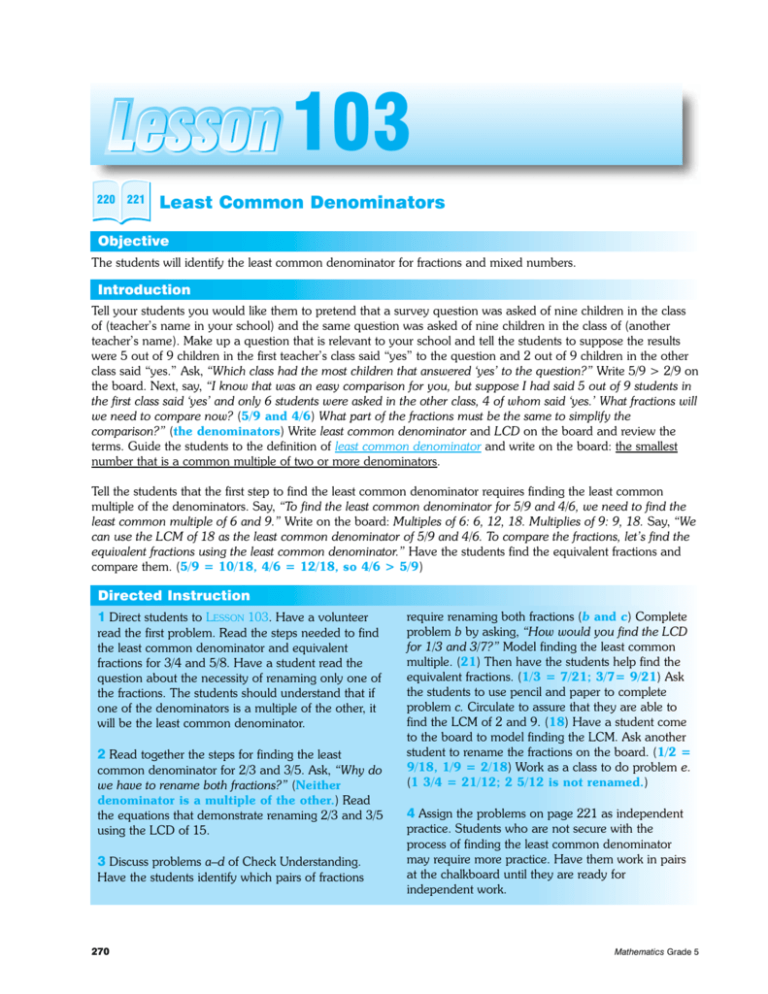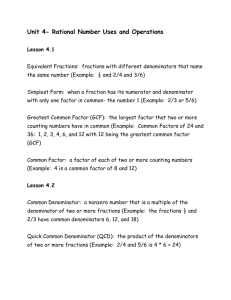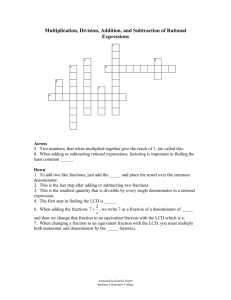Least Common Denominators
advertisement

103 220 221 Least Common Denominators Objective The students will identify the least common denominator for fractions and mixed numbers. Introduction Tell your students you would like them to pretend that a survey question was asked of nine children in the class of (teacher’s name in your school) and the same question was asked of nine children in the class of (another teacher’s name). Make up a question that is relevant to your school and tell the students to suppose the results were 5 out of 9 children in the first teacher’s class said “yes” to the question and 2 out of 9 children in the other class said “yes.” Ask, “Which class had the most children that answered ‘yes’ to the question?” Write 5/9 > 2/9 on the board. Next, say, “I know that was an easy comparison for you, but suppose I had said 5 out of 9 students in the first class said ‘yes’ and only 6 students were asked in the other class, 4 of whom said ‘yes.’ What fractions will we need to compare now? (5/9 and 4/6) What part of the fractions must be the same to simplify the comparison?” (the denominators) Write least common denominator and LCD on the board and review the terms. Guide the students to the definition of least common denominator and write on the board: the smallest number that is a common multiple of two or more denominators. Tell the students that the first step to find the least common denominator requires finding the least common multiple of the denominators. Say, “To find the least common denominator for 5/9 and 4/6, we need to find the least common multiple of 6 and 9.” Write on the board: Multiples of 6: 6, 12, 18. Multiplies of 9: 9, 18. Say, “We can use the LCM of 18 as the least common denominator of 5/9 and 4/6. To compare the fractions, let’s find the equivalent fractions using the least common denominator.” Have the students find the equivalent fractions and compare them. (5/9 = 10/18, 4/6 = 12/18, so 4/6 > 5/9) Directed Instruction 1 Direct students to LESSON 103. Have a volunteer read the first problem. Read the steps needed to find the least common denominator and equivalent fractions for 3/4 and 5/8. Have a student read the question about the necessity of renaming only one of the fractions. The students should understand that if one of the denominators is a multiple of the other, it will be the least common denominator. 2 Read together the steps for finding the least common denominator for 2/3 and 3/5. Ask, “Why do we have to rename both fractions?” (Neither denominator is a multiple of the other.) Read the equations that demonstrate renaming 2/3 and 3/5 using the LCD of 15. 3 Discuss problems a–d of Check Understanding. Have the students identify which pairs of fractions 270 require renaming both fractions (b and c) Complete problem b by asking, “How would you find the LCD for 1/3 and 3/7?” Model finding the least common multiple. (21) Then have the students help find the equivalent fractions. (1/3 = 7/21; 3/7= 9/21) Ask the students to use pencil and paper to complete problem c. Circulate to assure that they are able to find the LCM of 2 and 9. (18) Have a student come to the board to model finding the LCM. Ask another student to rename the fractions on the board. (1/2 = 9/18, 1/9 = 2/18) Work as a class to do problem e. (1 3/4 = 21/12; 2 5/12 is not renamed.) 4 Assign the problems on page 221 as independent practice. Students who are not secure with the process of finding the least common denominator may require more practice. Have them work in pairs at the chalkboard until they are ready for independent work. Mathematics Grade 5 Math Moments 1. Ask the students to tell the least common multiple for each pair: 2 and 3 (6), 3 and 4 (12), 3 and 5 (15), 5 and 6 (30), 3 and 12 (12), 6 and 9 (18), 6 and 7 (42), 7 and 8 (56). 2. Make the following statement to the students, asking them to find the equivalent fraction: “3/4 has an equivalent fraction. The sum of its numerator and denominator is 21.” (9/12) Repeat the statement, substituting the following fractions and sum combinations: 2/3 and 15 (6/9); 1/2 and 15 (5/10); 1/5 and 24 (4/20); 3/8 and 22 (6/16); 4/5 and 180 (80/100). After you have done the examples given, have the students make up similar problems for each other. 3. Ask each student to write a fraction on a piece of paper. The fraction should have a number between 2 and 15 as its denominator and should not be an improper fraction. Select a student to come forward to show classmates the fraction he or she wrote. Have another student who wrote a fraction with a different denominator bring that fraction and come forward. Ask the students to write on the board to show the class how to find the least common denominator of their fractions. For an added challenge, have three students whose fractions have different denominators come forward to demonstrate finding the least common denominator with three fractions. Practice Have the students play What’s It Worth? for practice with finding the least common denominator to compare fractions. Pairs of students will need two sets of digit cards from Blackline Master M5-004B. (Discard the 0 and 1 for play; to make the game more difficult, have students make their own sets of cards up to 20.) To play, one partner draws two number cards to make a fraction, using one number for the numerator and one for the denominator. The object is to make a fraction with the greatest possible value. The other partner attempts to make a greater fraction by drawing two number cards. The students must use the least common denominator to find the two equivalent fractions and compare them. A point is awarded to the player who is able to make the greater fraction for that round of play. © Copyright 2001 Moments with the Master In Genesis 45, we read an example of God’s attributes of forgiveness and generosity. Although Joseph’s brothers had sold him into slavery, he helped them when they came to Egypt for food. In verse 5, we read that Joseph told his brothers, “But now, do not therefore be grieved or angry with yourselves because you sold me here; for God sent me before you to preserve life.” Then Joseph gave his brothers carts, changes of garments, three hundred pieces of silver and twenty donkeys. Ten of the donkeys were “loaded with grain, bread, and food . . . .” (verse 23). Joseph’s brothers had only requested to buy some grain, but God used Joseph to give them more than they needed. This is the way of our Father, Who does not give us a mere fraction of what we need. He gives generously and desires that His children do the same. Answer Key CONSTRUCT MEANING One fraction already had 8 as the denominator. CHECK UNDERSTANDING a. no b. yes c. yes e. 1 9/12 and 2 5/12 d. no PRACTICE 1. 3/6; 2/6 2. 4/10; 3/10 3. 8/12; 9/12 4. 24/40; 25/40 5. 9/18; 2/18 6. 16/24; 3/24 7. 5/20; 12/20 8. 3/18; 10/18 4 3/6; 1 4/6 2 4/6; 6 5/6 10. 11. 12. 10 6/8; 5 5/8 1 12/30; 2 5/30 13. 1/4 and 1/9 14. 1/16 and 1/3 9. APPLY Betsy lives closer; 1/24 mile 16. The backpack weighing 5 3/5 lb is lighter. 15. 17. They had 2 5/8 cups and needed 2 3/4; they needed 1/8 cup more. 18. Yes, an infinite number of common denominators. Using the LCD simplifies working with fractions. 271







